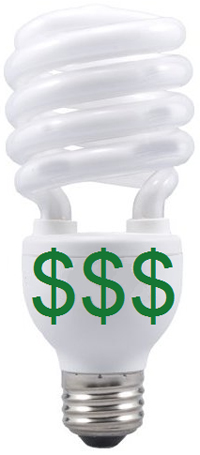Press Release: Carnegie Mellon Researchers Find Consumers Choose More Efficient Light Bulbs When Energy Costs Are Labeled
Contact: Chriss Swaney / 412-268-5776 / swaney@andrew.cmu.edu
 PITTSBURGH—Is it worth paying more for that energy-saving light bulb? That depends how much you value savings today versus savings in the future, according to Carnegie Mellon University researchers.
PITTSBURGH—Is it worth paying more for that energy-saving light bulb? That depends how much you value savings today versus savings in the future, according to Carnegie Mellon University researchers.
CMU’s Jihoon Min, an engineering and public policy doctoral student, CMU professors Ines Azevedo and Jeremy Michalek and University of Leeds Professor Wandi Bruin de Bruin studied how consumers choose light bulbs.
“Lighting accounts for one fifth of U.S. electricity consumption — and the vast majority of the upstream energy used to make light goes to waste, with only a small fraction being converted to light,” Azevedo said. “Energy-efficient bulbs, like compact fluorescent lamps, or CFLs, can go a long way in saving energy and reducing harmful emissions.”
To understand the willingness to adopt these technologies, the team conducted experiments with consumers.
“We used a mobile lab so we could meet people in a shopping area,” Min said. “We invited them in and asked them to make several choices among alternative light bulbs. By testing bulbs of different type, price, brightness, power, color and lifetime, and observing the choices people make, we can infer which aspects are most important to determining which bulb a consumer will buy.”
Energy-efficient bulbs are typically more expensive to purchase but cheaper to operate, researchers said.
“The trick with energy-efficient bulbs,” Michalek said, “is that the extra cost happens up front at the point of purchase, and the savings happen later with lower electricity bills. We found that consumers behave as though they value a dollar of savings today as much as only 15 cents of savings next year. When consumers value up-front savings so much more than future savings, efficient bulbs don’t look very attractive.
“But when we include the estimated annual energy cost on the label, consumers behave as though saving a dollar today is worth the same as saving 50 cents next year. They still prefer savings in the present, but they are more aware of future costs and give energy efficient bulbs more of a chance,” Michalek said.
The report, to appear in the journal Ecological Economics, suggests that new labels implemented by the Federal Trade Commission (FTC) in 2012, which include operating cost information, are likely to help increase adoption of efficient light bulbs.
The study, which was funded by the Russell Sage Foundation and the Climate and Energy Decision Making Center through a cooperative agreement between the National Science Foundation (NSF) and CMU, also suggests that not all consumers are the same.
“Lower income consumers are most sensitive to the timing of savings while high income consumers are more willing to invest now in order to save more money in the long run,” Azevedo said. So, it may be particularly challenging to persuade lower income households to invest, even when the rate of payback for these bulbs is higher than what could be earned in a bank account or the stock market.”
The researchers say that energy cost labels appear to be an effective approach for informing consumers.
“We don’t see a significant connection between consumer knowledge of lighting technologies or perception of climate change in determining their choices. But show consumers what it costs to operate these bulbs, and they are much more willing to invest in efficient technologies,” Azevedo said.
###
Energy-efficient bulbs, like compact fluorescent lamps, or CFLs (pictured above), can go a long way in saving energy and reducing harmful emissions.